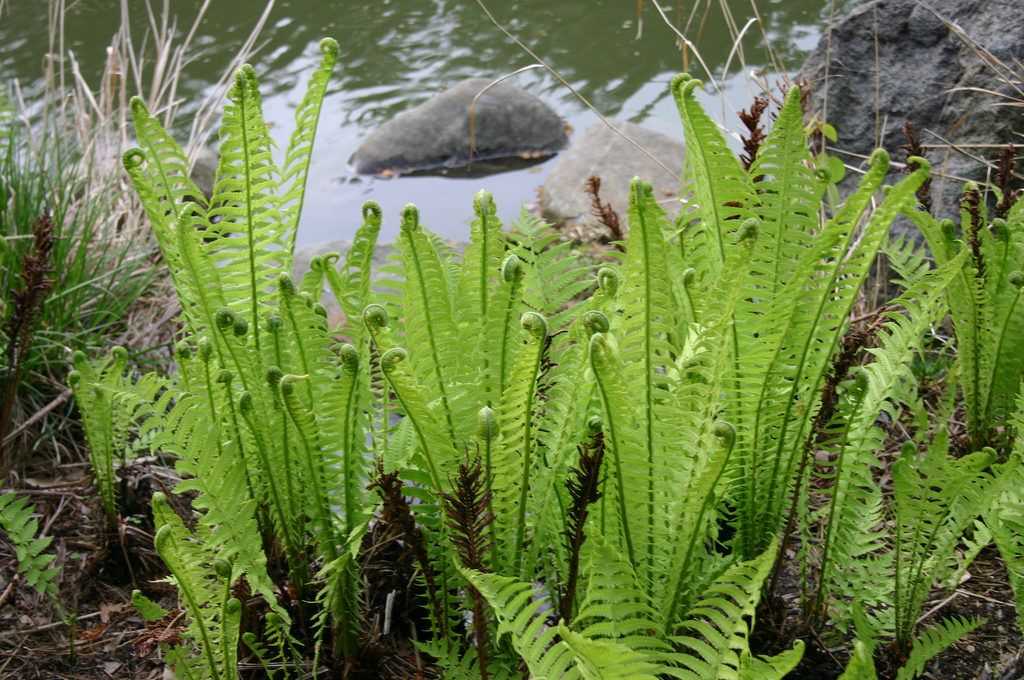Delectable Fiddlehead Harvest
By: Remy Crettol & Rowan Cignoni
The Fiddlehead Conundrum
As winter melts away and April showers promise spring, the Winooski River braces itself to be overwhelmed. Water flows from all corners of the landscape until the river can hold no more. As water breaches the banks of the river, it spills onto the flat surrounding land and deposits rich sediment. These alluvial deposits bring life to the Winooski floodplain in the form of dense, diverse vegetation.

Ostrich ferns (Matteuccia struthiopteris), best known as delectable fiddleheads, are a relic of old growth floodplain forests. Few species influence forest composition as much as the ostrich fern. Often sheltered by a towering silver maple canopy, ostrich ferns form thick fibrous mats in the understory that provide firm footing for the trees and protect the riverbanks from erosion. They also discourage invasive species by casting deep shade and monopolizing the soil surface. Sterile fronds emerge as a deep green fiddlehead with a brown papery covering in the early spring. They quickly unfurl reaching two to five feet in height. Ostrich ferns are valuable members of the natural community.
The fiddleheads of ostrich ferns are also valuable commodities on the seasonal menus of many farm-to-table restaurants. Wild foods add diversity to one’s diet and are macro and micronutrient-dense because they haven’t been domesticated and hybridized to fit agricultural needs. They are healthy, unique, and delicious spring edibles. For all these wonderful qualities, their economic value makes the ostrich fern a species of concern – especially in urban areas where demand is high and economic incentive encourages overharvesting. Not only foragers profit, but the markets who sell and the restaurants that serve fiddleheads also profit. This distribution chain demands that we question, “How can a ‘sustainable’ standard be enforced?”

The City of Burlington and the Winooski Valley Park District face the issue of fiddlehead overharvest on public land, especially in McKenzie Park and the Ethan Allen Homestead. Both properties provide the perfect environmental conditions to support silver maple-ostrich fern floodplain forests. Since ostrich fern grows abundantly at these sites it can give foragers a false impression that their populations are limitless. In reality, ostrich fern habitat is largely restricted to the lower Winooski River floodplain where most of the land is used for agricultural purposes. Very little has been allowed to revert back to natural forest. Lands that are conserved are heavily fragmented and deeply impacted by overharvesting.
Burlington faces the challenging task of balancing the food interests of its local communities, and the conservation and protection of its natural resources. Dan Cahill, Land Steward for the City of Burlington, the Winooski Valley Park District, and students from UVM under Professor Bill Keaton, are working to address the issue in an informed and integrative way. Approaches that are being explored to address the issue include:
- Mapping ostrich fern populations
- Monitoring populations before and after harvest season and measuring rate of regeneration.
- Posting signage with education and outreach information
- Recruiting volunteer educators to be stationed at sites where overharvesting is an issue to protect populations and provide information to the public.
If you are interested in volunteering to help protect ostrich fern populations contact Dan Cahill at: Dcahill@burlingtonvt.gov or Remy Crettol from the Winooski Valley Park District at: americorps@wvpd.org
In the meantime, local fiddlehead foragers would be wise to protect this common resource by practicing sustainable, even regenerative harvesting practices. Best practices recommend that you:
- Harvest wild food as far away from the nearest settlement as possible. While disturbing remote wilderness carries a host of implications, most wilderness areas are resilient ecological communities. By gathering in remote areas, foragers reduce the likelihood of disturbing the same areas repeatedly.
- Be able to identify the ostrich fern fiddleheads. Some look alike fiddleheads can make you sick.
Ostrich fern closely resembles cinnamon fern and interrupted fern in overall size, shape, and structure but can be distinguished by the ostrich-feather shape of the leaf. The short leaflets of ostrich fern continue to the base of the stalk and lack forked veins on the underside.
- Know the life cycle of the species. They become bitter once the fiddlehead unfurls into a frond.
- Take few, leave many. Ferns reproduce via sporulation. If all the fronds are removed, the plant cannot photosynthesize or create spore to reproduce.
- Take only what you plan to consume. Harvesting for one’s self and family rarely poses a problem.
Foragers interested in a new level of participatory ecology may consider propagating ostrich fern for conservation plantings. This regenerative approach to gathering wild foods may be essential to the protection of the commons – you can learn more about this relatively simple practice here.
